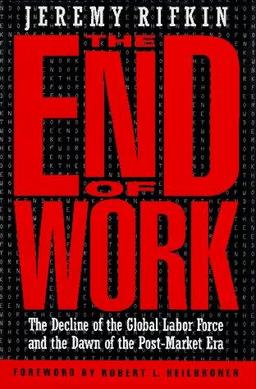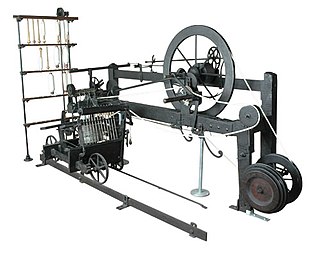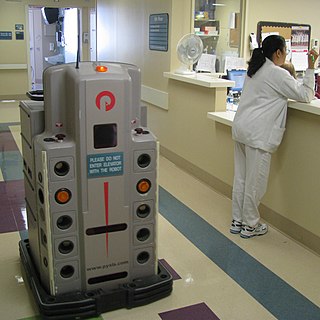
Innovation is the practical implementation of ideas that result in the introduction of new goods or services or improvement in offering goods or services. ISO TC 279 in the standard ISO 56000:2020 defines innovation as "a new or changed entity realizing or redistributing value". Others have different definitions; a common element in the definitions is a focus on newness, improvement, and spread of ideas or technologies.
The knowledge economy, or knowledge-based economy, is an economic system in which the production of goods and services is based principally on knowledge-intensive activities that contribute to advancement in technical and scientific innovation. The key element of value is the greater dependence on human capital and intellectual property as the source of innovative ideas, information and practices. Organisations are required to capitalise on this "knowledge" in their production to stimulate and deepen the business development process. There is less reliance on physical input and natural resources. A knowledge-based economy relies on the crucial role of intangible assets within the organisations' settings in facilitating modern economic growth.
Productivity is the efficiency of production of goods or services expressed by some measure. Measurements of productivity are often expressed as a ratio of an aggregate output to a single input or an aggregate input used in a production process, i.e. output per unit of input, typically over a specific period of time. The most common example is the (aggregate) labour productivity measure, one example of which is GDP per worker. There are many different definitions of productivity and the choice among them depends on the purpose of the productivity measurement and data availability. The key source of difference between various productivity measures is also usually related to how the outputs and the inputs are aggregated to obtain such a ratio-type measure of productivity.
Technocapitalism or tech-capitalism refers to changes in capitalism associated with the emergence of new technology sectors, the power of corporations, and new forms of organization. Technocapitalism is characterised by constant innovation, global competition, the digitisation of information and communication, and the growing importance of digital networks and platforms.
Technological change (TC) or technological development is the overall process of invention, innovation and diffusion of technology or processes. In essence, technological change covers the invention of technologies and their commercialization or release as open source via research and development, the continual improvement of technologies, and the diffusion of technologies throughout industry or society. In short, technological change is based on both better and more technology.
Hirsh Zvi Griliches was an economist at Harvard University. The works by Zvi Griliches mostly concerned the economics of technological change, including empirical studies of diffusion of innovations and the role of R & D, patents, and education. In 2023 he had 126 publication listed in Web of Science and a Hirsch index of 49, which places him into 2% of most productive economics professors in the USA.

Emerging technologies are technologies whose development, practical applications, or both are still largely unrealized. These technologies are generally new but also include older technologies finding new applications. Emerging technologies are often perceived as capable of changing the status quo.
Richard George Lipsey, is a Canadian academic and economist. He is best known for his work on the economics of the second-best, a theory that demonstrated that piecemeal establishing of individual first best conditions would not necessarily raise welfare in a situation in which all first best conditions could not be satisfied, an article that he co-authored with Kelvin Lancaster. He is currently Professor Emeritus of Economics at Simon Fraser University.
Economic stagnation is a prolonged period of slow economic growth, usually accompanied by high unemployment. Under some definitions, slow means significantly slower than potential growth as estimated by macroeconomists, even though the growth rate may be nominally higher than in other countries not experiencing economic stagnation.
The Gerschenkron effect, developed by Alexander Gerschenkron, claims that changing the base year for an index determines the growth rate of the index. This effect is applicable only to aggregation method using reference price structure or reference volume structure. However, if production is measured by "real" tearms, this effect does not exist.

The End of Work: The Decline of the Global Labor Force and the Dawn of the Post-Market Era is a non-fiction book by American economist Jeremy Rifkin, published in 1995 by Putnam Publishing Group.
Innovation economics is new, and growing field of economic theory and applied/experimental economics that emphasizes innovation and entrepreneurship. It comprises both the application of any type of innovations, especially technological, but not only, into economic use. In classical economics this is the application of customer new technology into economic use; but also it could refer to the field of innovation and experimental economics that refers the new economic science developments that may be considered innovative. In his 1942 book Capitalism, Socialism and Democracy, economist Joseph Schumpeter introduced the notion of an innovation economy. He argued that evolving institutions, entrepreneurs and technological changes were at the heart of economic growth. However, it is only in recent years that "innovation economy," grounded in Schumpeter's ideas, has become a mainstream concept".
Vernon Wesley Ruttan (1924–2008) was a development economist at the University of Minnesota, where he was Regents Professor Emeritus in the Departments of Economics and Applied Economics. Ruttan's research focused on agricultural development, induced innovation, technical change and productivity growth, institutions, and development assistance policy. His book with Yujiro Hayami, Agricultural Development: An International Perspective (1971) was considered a classic in the field and was translated into four other languages.

A technological revolution is a period in which one or more technologies is replaced by another novel technology in a short amount of time. It is a time of accelerated technological progress characterized by innovations whose rapid application and diffusion typically cause an abrupt change in society.

The Federal Ministry of Innovation, Science and Technology is a Nigerian ministry whose mission is to facilitate the development and deployment of science and technology apparatus to enhance the pace of socio-economic development of the country through appropriate technological inputs into productive activities in the nation. It is headed by a Minister appointed by the President, assisted by a Permanent Secretary, who is a career civil servant. President Bola Tinubu, GCFR on 16 August 2023 appointed Uche Nnaji as the Minister of Science and Technology. Mr James Sule, mni is the current permanent secretary in the ministry.

The productivity-improving technologies are the technological innovations that have historically increased productivity.

Technology, society and life or technology and culture refers to the inter-dependency, co-dependence, co-influence, and co-production of technology and society upon one another. Evidence for this synergy has been found since humanity first started using simple tools. The inter-relationship has continued as modern technologies such as the printing press and computers have helped shape society. The first scientific approach to this relationship occurred with the development of tektology, the "science of organization", in early twentieth century Imperial Russia. In modern academia, the interdisciplinary study of the mutual impacts of science, technology, and society, is called science and technology studies.

Technological unemployment is the loss of jobs caused by technological change. It is a key type of structural unemployment. Technological change typically includes the introduction of labour-saving "mechanical-muscle" machines or more efficient "mechanical-mind" processes (automation), and humans' role in these processes are minimized. Just as horses were gradually made obsolete as transport by the automobile and as labourer by the tractor, humans' jobs have also been affected throughout modern history. Historical examples include artisan weavers reduced to poverty after the introduction of mechanized looms. During World War II, Alan Turing's bombe machine compressed and decoded thousands of man-years worth of encrypted data in a matter of hours. A contemporary example of technological unemployment is the displacement of retail cashiers by self-service tills and cashierless stores.

Professor Xiaolan Fu is a British-based Chinese economist, and Fellow of the Academy of Social Sciences. She is the Founding Director of the Technology and Management Centre for Development (TMCD). She is a Professor of Technology and International Development and Fellow of Green Templeton College at the University of Oxford.
Carol A. Corrado is an American economist who was the former chief of industrial output at the Federal Reserve Board and currently serves as a senior advisor and research director in economics on The Conference Board. She serves as a member of the executive committee for the National Bureau of Economic Research's (NBER) conference on research on income and wealth. She is a senior policy scholar at Georgetown University McDonough School of Business Centre for Business and Public Policy where she focuses on economics of growth and innovation as well as fiscal and monetary policies. In addition to these positions, Corrado is involved with the American Statistical Association as well as the Technical Advisory Committee of the Bureau of Labor Statistics. With the American Statistical Association Corrado serves as the chair-elect of Business and Economics.








